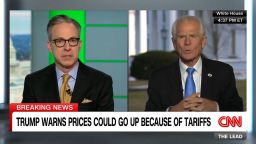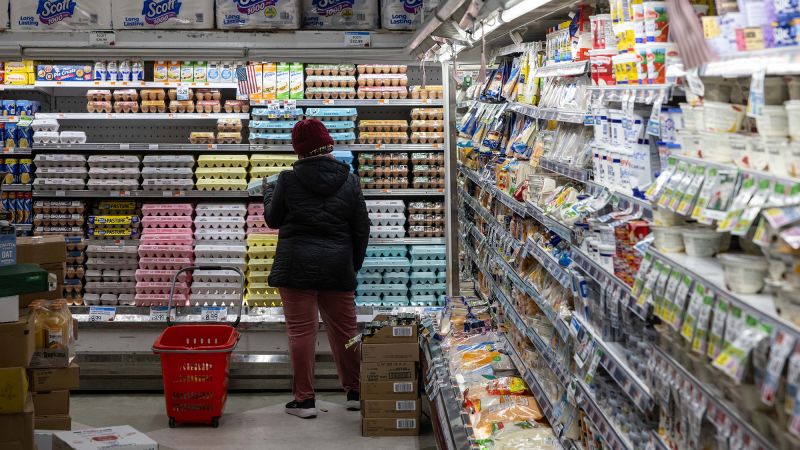—
President Donald Trump, in an interview with Fox News’ Sean Hannity that aired Tuesday night, acknowledged that inflation is on the rise again — bucking his campaign promise to lower prices immediately upon taking office. But he said the Biden administration’s runaway spending is to blame.
“Inflation is back,” Trump said. “I had nothing to do with it. These people have — have run the country. They spent money like nobody has ever spent.”
Trump is right about the return of inflation: Consumer prices rose much more than expected last month, the Bureau of Labor Statistics reported last week — buoyed in particular by surging fuel and egg prices. January marked the biggest monthly increase since August 2023. And prices were 3% higher year-over-year for the first time since June 2024.
The president is also right that he can’t shoulder much of the blame: Former President Joe Biden occupied the Oval Office for 19 ½ of the 31 days covered by the most recent report.
But Trump’s argument that Biden is to blame for inflation is up for debate. Economists disagree about why, exactly, inflation surged after Biden became president before coming back down to near-normal levels. Prices rose throughout Biden’s first year in office and inflation spiked in his second year, reaching a 40-year high in June 2022 before falling.
Trump on Tuesday night appeared to blame inflation on Biden’s push for a “Green New Scam,” although it wasn’t exactly clear what his claim referred to. No such bill ever passed.
“They were given $9 trillion to throw out the window — $9 trillion, and they spent it on the Green New Scam, I call it,” Trump said. “It’s the greatest scam in the history of the country.”
Biden signed an infrastructure bill that included green energy projects and cost more than $1 trillion in 2021 and Covid relief that totaled $3.4 trillion. Combined, they added roughly $5 trillion to the deficit in his first two years, according to the Committee for a Responsible Federal Budget. Biden’s signature Inflation Reduction Act, which also included a combination of tax credits and spending, actually saved the government $240 billion because of increased tax enforcement and prescription drug savings, according to the CRFB. Republicans took over the House of Representatives in 2023, and Biden did not pass any substantial legislation in his last two years in office.
Some economists, including former Federal Reserve Chair Ben Bernanke, have in part blamed the substantial spending for overheating the economy.
“The US response to the COVID-19 pandemic included a series of federal initiatives, notably the CARES Act and the American Rescue Plan, which collectively authorized roughly $5 trillion in government spending,” noted the authors of a September 2023 National Bureau of Economic Research report. “These programs contributed to strong consumer and business demand, which tightened labor markets (between mid-2021 and early 2022 the ratio of job vacancies to unemployed workers doubled), putting upward pressure on wages and prices.”
But the same report also blamed the price hikes on factors including higher production costs linked to swings in demand, the war in Ukraine and Covid-era supply trouble.
The BLS in a January 2023 report blamed inflation on “volatility of energy prices, backlogs of work orders for goods and services caused by supply chain issues due to COVID-19, and price changes in the auto-related industries.”
And the International Monetary Fund said in a September 2024 report that macroeconomic effects like federal spending weren’t to blame at all — instead it was just old-fashioned supply and demand.
So the jury is decidedly out on how much federal spending contributed to inflation — if at all. Trump may be right that the Biden administration spent too much at the wrong time. But economists agree that alone didn’t cause inflation to spike.
And it certainly isn’t what’s driving prices higher now. Prices have remained stubbornly high as bird flu boosted egg prices at the fastest rate in 10 years and a combination of slumping demand and sanctions on Russia and Iran continued to raise fuel prices.
Prices were up across the board last month, though — not just those volatile and hard-to-control categories like food and fuel. That will almost certainly halt the Fed’s efforts to lower interest rates, keeping the cost of borrowing high for American consumers and homebuyers — and mortgages and rents have been a persistent source of inflation.
Another thing that won’t help prices: Trump’s tariffs. Raising taxes on imports will ultimately cost the American consumers who will be left footing the bill, economists largely agree. That could negate savings realized from his plans to cut spending, cut taxes and increase fossil fuel drilling licenses.
So Biden may have contributed to America’s stubborn inflation problem. But it’s now Trump’s problem, and his most prominent economic policy may make it worse.





